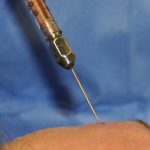Aging of the lower eyes is marked by loose skin and wrinkles, herniating fat and often the presence of a tear trough groove. This has led to the commonly used blepharoplasty approaches of skin and fat removal. The treatment focus has been on tissue removal and tightening. While generally successful as defined by making improvements, such tissue removal is not ideal for everyone particularly those patients that have orbital hollowing and periorbital fat atrophy.
One of the recognized novel observations in facial aging is the recognition that most people will develop loss of tissue volume due to fat absorption. Deflation of the face is the sine que non of loss of one’s youth. While this can occur all over the face, it can be most striking in the periorbital area with the sunken eye appearance. The well recognized tear trough deformity of the lower eyelid is a sequelae of tissue thinning although some patients have it naturally at a young age.
As fat is being put back and injected over every area of the face, the lower eyelid and cheek region is no exception. Good candidates are those patients that have sunken lower eyelids and a clear demarcation between the lower eyelid and the cheek area. This demarcation exists because the bottom part of the lower eyelid has fallen back over the lower orbital rim due to lack of soft tissue support. (which is also the cause of the more medial tear trough deformity)

Lower eyelid fat grafting can be done alone or in conjunction with transconjunctival removal of herniated fat, pinch blepharoplasties and lower eyelid chemical peels. Up to 3 to 7cc of concentrated fat can be injected per side. While very small injection cannulaes are used, bruising is still a distinct possibility. By adding volume to the lower eyelid and cheek areas, the lid level can actually be raised. This can be particularly useful when some degree of sclera show exists.
Unlike other areas of the face, fat injections around the eye area have very good volume retention. Overcorrection is not done because of how well it may last.
Rejuvenation of aging eyes today is more than just about removing loose and protruding tissues. A more contemporary approach is to add volume if needed through fat injections. Sunken in eyes and tear troughs can be greatly improved by fat addition. As it becomes more widely done, it will become part of more lower blepharoplasty treatment approaches.
Dr. Barry Eppley
Indianapolis, Indiana


